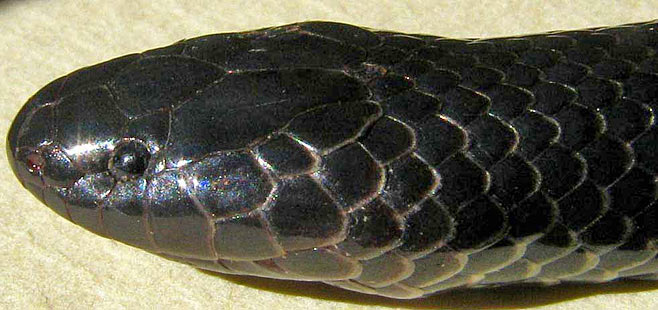|
Amblyodipsas concolour (Natal purple-glossed snake)
Natalse persglansslang; Natalse purpergrondslang [Afrikaans]
Life >
Eukaryotes
>
Opisthokonta >
Metazoa
(animals) > Bilateria > Deuterostomia >
Chordata >
Craniata > Vertebrata (vertebrates) > Gnathostomata (jawed vertebrates) >
Teleostomi (teleost fish) > Osteichthyes (bony fish) > Class:
Sarcopterygii (lobe-finned fish) > Stegocephalia (terrestrial vertebrates) >
Tetrapoda
(four-legged vertebrates) > Reptiliomorpha > Amniota >
Reptilia (reptiles) >
Romeriida > Diapsida > Lepidosauromorpha > Lepidosauria >
Squamata > Serpentes
(snakes) > Family: Atractaspididae > Genus:
Amblyodipsas
 |
|
Amblyodipsas concolour (Natal purple-glossed snake),
Mpumalanga, South Africa. [photo M. Douglas ©, from
SARCA
Virtual Museum] |
Identification
The Natal purple-glossed snake can be identified by its
thick body, a blunt head, a purple colouration, small eyes and habit of burrowing
beneath the surface. It grows to an average length of 50 cm but may reach up to
85 cm in length.
Distribution and habitat
Found in KwaZulu-Natal and Limpopo. It is found
in a variety of habitats including moist savanna and lowland forest.
Food
Adults eat other snakes and juveniles eat lizards
(particularly skinks).
Predators, parasites and disease
Eaten by other snakes.
Reproduction
Uncertain, records differ as to whether it is oviparous
(egg-laying) or viviparous (bearing live young).
Longevity
Has an average life span of 20 years.
Medical importance
Although venomous it is not thought to be dangerous to man.
Links
References
-
Broadley, D.G. 1983. FitzSimons' Snakes of Southern
Africa. Delta Books, Johannesburg.
-
Marais, J. 2004. A Complete Guide to Snakes of Southern Africa.
Struik Publishing, Cape Town.
|
